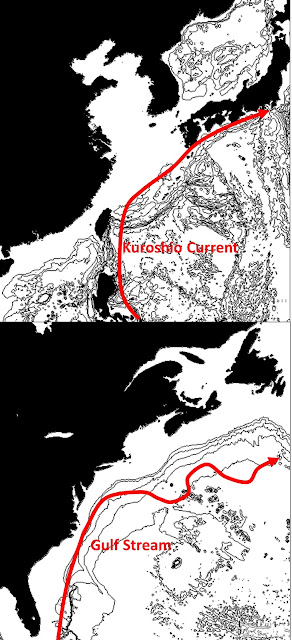Parallel universe
Leaning forward in my black leather chair, I grabbed my mug and took a sip of my green tea. The tea leaves were floating loose in the water, unencumbered by a mesh strainer. The hot water felt good on my throat. It was early morning, and I was in yet another conference room, this time back at OUC. Another WHOI scientist who was unable to travel with us video-conferenced into the meeting, and I listened to his voice rining out from Ji's laptop. One by one, his slides changed on the projector screen. I hugged my tea mug with my hands and leaned back onto the chair. I was relaxed.
 The meeting was for another WHOI-OUC project, and a large part of the discussion actually focused on similarities between Chinese and American oceanography. Think about this: both China and the U.S. have long eastern coasts that span sub-tropical and temperate latitudes. The east coast of China and the east coast of the U.S. both have a broad continental shelf and a strong current system - the Gulf Stream in the Atlantic, the Kuroshio Current in the Pacific. Both currents bring warm tropical water north and control the regional climate. Both countries have lucrative fisheries, especially for cod, along their eastern coasts.
The meeting was for another WHOI-OUC project, and a large part of the discussion actually focused on similarities between Chinese and American oceanography. Think about this: both China and the U.S. have long eastern coasts that span sub-tropical and temperate latitudes. The east coast of China and the east coast of the U.S. both have a broad continental shelf and a strong current system - the Gulf Stream in the Atlantic, the Kuroshio Current in the Pacific. Both currents bring warm tropical water north and control the regional climate. Both countries have lucrative fisheries, especially for cod, along their eastern coasts.
As the meeting went on, I scribbled notes to myself. The similarities between American and Chinese oceanography allow for some really interesting comparisons. It's like there's a parallel universe on the other side of the globe where we can test our scientific theories. Actually the most interesting part might be the few key differences between the western Atlantic and the western Pacific. Chinese waters are trawled much more extensively than U.S. waters, leaving fish populations low and the benthos highly disturbed. The Gulf Stream is well-renowned for meandering and pinching off warm-core eddies that deliver tropical water to the coast, while the Kuroshio does not. In science, you want all factors to be controlled except the one you're testing, so the similarities between American and Chinese seas provide an opportunity to test for ecosystem-level effects of the few differences that exist.
It was a productive meeting, and I look forward to seeing how the comparative project develops in the future!
 The meeting was for another WHOI-OUC project, and a large part of the discussion actually focused on similarities between Chinese and American oceanography. Think about this: both China and the U.S. have long eastern coasts that span sub-tropical and temperate latitudes. The east coast of China and the east coast of the U.S. both have a broad continental shelf and a strong current system - the Gulf Stream in the Atlantic, the Kuroshio Current in the Pacific. Both currents bring warm tropical water north and control the regional climate. Both countries have lucrative fisheries, especially for cod, along their eastern coasts.
The meeting was for another WHOI-OUC project, and a large part of the discussion actually focused on similarities between Chinese and American oceanography. Think about this: both China and the U.S. have long eastern coasts that span sub-tropical and temperate latitudes. The east coast of China and the east coast of the U.S. both have a broad continental shelf and a strong current system - the Gulf Stream in the Atlantic, the Kuroshio Current in the Pacific. Both currents bring warm tropical water north and control the regional climate. Both countries have lucrative fisheries, especially for cod, along their eastern coasts.As the meeting went on, I scribbled notes to myself. The similarities between American and Chinese oceanography allow for some really interesting comparisons. It's like there's a parallel universe on the other side of the globe where we can test our scientific theories. Actually the most interesting part might be the few key differences between the western Atlantic and the western Pacific. Chinese waters are trawled much more extensively than U.S. waters, leaving fish populations low and the benthos highly disturbed. The Gulf Stream is well-renowned for meandering and pinching off warm-core eddies that deliver tropical water to the coast, while the Kuroshio does not. In science, you want all factors to be controlled except the one you're testing, so the similarities between American and Chinese seas provide an opportunity to test for ecosystem-level effects of the few differences that exist.
It was a productive meeting, and I look forward to seeing how the comparative project develops in the future!
Comments
Post a Comment